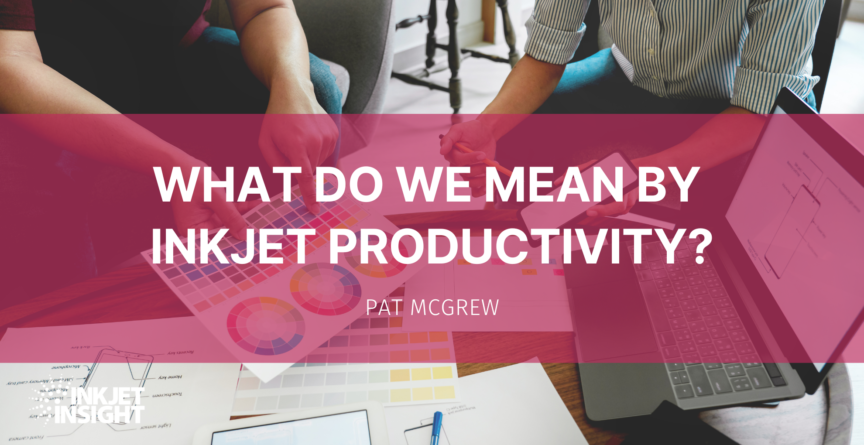Like beauty, productivity is in the eye of the beholder. Inkjet comes in myriad forms with diverse requirements but let’s agree that, for inkjet systems, we are looking for combinations of speed, quality, and efficiency along with a sprinkling of low maintenance impact and high uptime. All of that in the context of the job the printhead is asked to perform. It’s more than dropping ink on a substrate; different environments have different needs.
Industrial Productivity
Industrial printheads are asked to operate in all types of conditions – consider inkjet printers producing output in warehouses, manufacturing, chemical production, or outdoor settings where temperature and humidity are only two variables. From scannable barcodes and directional labels to warehouse rack labels and post-print of pre-printed stock, output in this environment must be legible by code readers.
Productivity considerations are print quality at speed, uptime, and maintenance cycles. It is very easy to miss changes in a normally productive print head by failing to inspect the output regularly and missing preventive maintenance cycles. In addition to continuous, thermal, and piezo technology options, heads come in many width options, different nozzle options, and different resolutions. As you review the capabilities of candidate printheads, look at the print head width, supported ink types, and available line speed as it relates to your application.
As you calculate your productivity needs, test your expectations against your post-implementation environment to ensure your expectations are met!
Production Productivity
Production inkjet printers come in a wide range of implementations, including web-fed and cut-sheet paper handling and variations in print head management focused on single-pass printing on unprinted substrates, though at times, preprinted stock is post-printed on these devices.
For this section, the focus is not on the printers that sit on your desktop or at the end of an office aisle but on those devices that produce high-volume output for in-plants and print services providers who serve commercial, publication, direct mail, and transactional/regulatory sectors. Even in that grouping, there are distinctions between entry-level and lower-volume devices selling below $1 million and the big rigs that start there and command higher prices.
Across the range of production machines, productivity is still a function of who uses it and the target applications. Before rushing to buy the fastest device in the market, take some time to identify your needs because with greater speed comes greater investment. While buying a bit more than you need today can be an excellent business strategy, overbuying can be a waste of available capital. To determine your productivity needs, ask a few questions:
- Regardless of the equipment you are using today, what are your output requirements each day, week, and month?This can be hard since you may have daily, weekly, and monthly cycles. Look at your averages, but don’t forget to identify your peaks. What are the largest jobs you have that must go out in the shortest time frames?
- What footprint do you have available for equipment?Today you may have multiple machines running at speeds from in the 75 to 300 image per minute range. Alternatively, you may have web presses exceeding 500 feet per minute, producing multi-up, duplex work at blazing speeds. Every device has a footprint required including the space for access to add paper, remove printed work, and perform maintenance. How much space is what you currently have occupying and what additional space do you have available?The question is relevant because as you look at your current machines, or the machines you are considering, and look at the required footprint, you may find that there is value in supporting multiple devices that take a bit more room because of your load balancing or substrate variation requirements. That configuration may give you more flexibility and lead to more productivity in your specific business.
If your requirement is to handle long-run, fast turnaround work, or you can batch multiple short-run jobs using the same substrate, your path to high productivity may be a modern web-fed press. They come in all sizes, speeds, and substrate-handling configurations, and they continue to add features that make them versatile.
- What is your sensitivity to preventive maintenance routines?Inkjet devices are most productive when maintained according to vendor recommendations. Maintenance takes time, so as you are calculating productivity for your shop, remember to add in the daily maintenance as well as the more intense requirements of scheduled print head changes, print head flushes, and other elements your vendor suggests.Whether you run a 24/7 or 8/5 shop, regular maintenance is essential to getting the longest, highest-quality life from the print heads.
One of the truisms associated with production inkjet printing is that these machines work best when running at capacity. They are workhorses. Keep that in mind as you review your productivity requirements. What balance can you strike on machine size, speed, and capacity?
This is not everything to consider when looking at productivity, but it is a great starter set. If you have suggestions, pass them along and share with us! Have questions? Put them in the comments or get in touch.

